A Needs-Based Design Method for Product–Service Systems to Enhance Social Sustainability
Abstract
1. Introduction
2. Related Work
2.1. Human-Scale Development and Its Applications
2.2. Product and Service Design
3. Needs-Based Design Method for Product–Service Systems
3.1. Concept
3.2. Procedure
3.2.1. Step 1: Extracting Satisfiers and Barriers
3.2.2. Step 2: Extracting Functions
3.2.3. Step 3: Extracting Requirements
3.2.4. Step 4: Relating Requirements to Satisfiers and Barriers
3.2.5. Step 5: Redesigning Functions
- (1)
- Modify or remove functions that connect only to barriers;
- (2)
- Separate or modify functions that connect to both satisfiers and barriers;
- (3)
- Add functions that can realize satisfiers that have not been realized by existing functions.
4. Case Study: Needs-Based Functional Redesign of Smart Carts
4.1. Design Target
4.2. Application of the Proposed Method to a Smart Cart
4.2.1. Step 1: Extracting Satisfiers and Barriers
4.2.2. Step 2: Extracting Functions
4.2.3. Step 3: Extracting Requirements
4.2.4. Step 4: Relating Requirements to Satisfiers and Barriers
4.2.5. Step 5: Redesigning Functions
5. Discussion
5.1. Effectiveness and Applicability of the Proposed Method
5.2. Model of Connections Between the Functions of a Product–Service System and Satisfiers/Barriers
5.3. Method Used to Redesign Functions
5.4. Needs-Based Workshop for a Supermarket
6. Conclusions
Author Contributions
Funding
Institutional Review Board Statement
Informed Consent Statement
Data Availability Statement
Acknowledgments
Conflicts of Interest
Abbreviations
| SCP | Sustainable consumption and production |
| HSD | Human-scale development |
| PSS | Product–service system |
| QFD | Quality function deployment |
Appendix A
| Being | Having | Doing | Interacting | |
|---|---|---|---|---|
| Subsistence | healthy | N/A | buying foods, going to a shop | easy accessibility, helping each other, store for everyone |
| Protection | secure | N/A | using an eco-bag, convey my thoughts | rule compliance, information on products bought is not stored, always something you want, electricity in the store even in the case of a disaster |
| Affection | with someone, accepted | N/A | feeling grateful, feeling the personality, perceiving the producer’s care and dedication | store that makes us feel the seasons, gathering place (without buying), store rooted in the community, special feeling |
| Understanding | N/A | similar experiences | observing, associating with the product, broadening my horizons, going to the shop | dissemination of various information, dissemination of adequate information, interest in new things, love of new things |
| Participation | N/A | rewards card | recycling trash | reflecting opinions, ingenuity to facilitate participation, various ways to participate |
| Idleness | N/A | N/A | N/A | N/A |
| Creation | N/A | interest in new things, love of new things | becoming a producer, talking to people who don’t use supermarkets, acting and thinking | someone I can talk to, dissemination of various information |
| Identity | N/A | belief, principles, preferences, self-understanding | going to a shop I’ve never been to | supermarkets only in the local area |
| Freedom | capable of anything | information, options, means | challenging, having many options | N/A |
| Being | Having | Doing | Interacting | |
|---|---|---|---|---|
| Subsistence | in poor health, lack of products that seem safe | additive, items with high environmental impact, over-packaging, allergy, toxicant, virus (COVID-19) | buying overpriced items, choosing only high-calorie foods, telling a lie | no barrier-free paths, poor security around the store, traffic conditions, no stores nearby, disaster, only accessible by car, no allergy-friendly products |
| Protection | lost without knowing where to buy, easy for elderly cars to crash into, restricted who can enter, crowded | shopping bag, unsanitary foods | bringing children, losing track of the child | climate change, many imported items, spacious store, far from police station, excessive labor, many bad people, no windows kids running around, large parking space, mass production and consumption |
| Affection | tired, dirty, unsanitary, too low price, high price | no kindness, processed goods, items placed in a messy manner, little communication, sales of side dishes, food loss in stores | complaining in a harsh tone, taking from products with longer expiration dates, bad responding from the clerk, not carrying the products the family wants, not knowing the manufacturer | decline of local stores, no producer label, dirty shopping basket, cold waitresses, clerks with a bad attitude |
| Understanding | unsure how to use, counterfeited place of origin | unknown instructions or recipes, difficult items, misleading information, vague product information, excessive information, no price indication, deceptive advertising | shopping in less time, forgetting my glasses, going to a noisy place, not providing accurate information, greenwashing | advertisements that create preconceived notions, confusing price display, clerks lacking knowledge, shortened operating hours, masks and partitions |
| Participation | required to be a member, not a member, no discounts available due to non-membership | many items, many tasks, a small child, no notice of sale | forgetting to wear a mask, eating out, forgetting my rewards card, registering as a member | shortened operating hours, distant distance to stores, rainy day handling, crowded parking, lack of knowledge by employees, sold all kinds of things, inappropriate responding, no barrier-free access |
| Idleness | difficult to just look at items, spoken to | shopping apps, discount flyers, rewards card | going shopping for daily necessities, seeing a discount on a product I want, sacking | nobody but me can go shopping, music and advertising in the store, dirty toilets, lack of rest area, excessive handling, excessive advertising |
| Creation | coerciveness, tired, sold as a product kit | seasoning for single use, special detergent, no time to think, stereotype, goods at home, shopping list, cheap items, obvious answer, everything I want, unprocessed fish, fewer options | buying pre-cooked products, buying a cooking kit, not making one myself, choosing items in easy-to-reach positions | confusing display of items, advertisements in magazines and on TV, lack of variation, fewer items on display, fixed items, bundle selling |
| Identity | not a price I’m willing to pay, no size that I want, satisfied with what I have | recommendation of a friend, confidence in the brand, sense of discrimination, prejudice, limited personal choice | selecting based on low price, buying recommended products, buying brand name goods, buying as recommended, using the same ones as everyone else, using discount coupons, choosing products with someone else | different products for sale in different regions, TV advertising, products setting by the store, no place for requests to be heard, lack of variation, intrusive behavior |
| Freedom | in closing time, not a member, not available to hold in hands, interrupted | products difficult to dispose of, bundle, rewards card, sense of discrimination, high price | shopping in a fraction of the time, selecting by price, considering family preferences, going shopping with children, not matching the business hours with the rhythm of my life | working environment, excessive customer service, price, uncomfortable accounting due to lack of employees, small variety of items, short business hours, no refills, fewer employees |
| Being | Having | Doing | Interacting | |
|---|---|---|---|---|
| Subsistence | healthy | means of communication, money, willingness to buy, food availability | choosing safe ingredients, buying what’s good for health, shopping, staying healthy | online supermarket, proper temperature control and transportation, food quality control and preservation |
| Protection | protected personal information, honest | security, relief, safety, no need to go out | setting a password, searching for reviews, making sure the company is safe | secure membership site, inquiry support, check for broken eggs, prevention of intrusion of suspicious persons, safe driving, separated by refrigerated, frozen, and room temperature |
| Affection | N/A | family, producer information, love for family, desire to cook for you | thinking of my family, knowing the story of products, asking what you want to eat, serving your favorite homemade food, receiving words of kindness, knowing food preferences in the family | wide variety of products, shopping list, project that tries to make users’ lives more enjoyable, never out of stock |
| Understanding | intuitive, easy to search for products | production and processing information, information on how to use the ingredients, payment method such as credit card, information on how to use an online supermarket, ingredient allergies | learning about the product development story, finding out what you need to know, knowing the attitude of the supermarkets and their approach to society, knowing the rationale for price, understanding how online supermarkets work, comparing and contrasting, enlarging product image | inquiry support, information about producers and products, careful product description, clear product image |
| Participation | available when I want | reason not to use real stores, expectation, online supermarket I want to use, PC/smartphone, internet literacy, interests, concerns, awareness, benefits of participation, first time use discount | gathering information from reviews, registering as a member, learning about the unique benefits of online supermarkets, earning points, matching delivery time with the time I want to pick up | reviews that show advantages, ease of member registration, delivery area, demonstration |
| Idleness | easy to buy | package receiving options, plan, time, subscription, nothing to think about, automatic selection of what to buy | setting up a pickup box, deciding on a menu, deciding what to buy, taking advantage of gaps in time, buying anytime, anywhere, not buying anything extra | regular delivery, recommendation, subscription delivery, past history purchase, automatic selection |
| Creation | N/A | social media, good memories of the past, request from family, number of recipes, knowledge and wisdom about shopping and cooking, recipes for popular dishes, good combination, ability to search | deciding on a menu, thinking about what is missing, asking what others are making, finding out how to use the ingredients, knowing the season, having a recipe in mind | recommendation, recipe suggestions tailored to the ingredients |
| Identity | in fashion, told that it tastes good, praised by family members, recognized for the hard work, praised for buying good stuff | information on trends, shopping deals, information on seasonal ingredients, family smiles, information on sales campaign, recipes for popular dishes, good arrangements | buying my favorite foods, making the best use of my spare time, finding out on social media, arranging to my liking, buying quickly, getting a good deal, completing of work as a homemaker | team spirit, suggestions for dishes I don’t know |
| Freedom | available for order 24 h, free to cook | easy operation and routine, money, options of pick-up time, no need to go to the supermarket, no need to move, no need to wander around | buying in the gap time, shopping light and easy, shopping without worrying about time, deciding on my own, shopping without worrying about weight, shopping while rummaging around, buying whatever I like, taking my time in choosing, making what you want to make | language-independent, free shipping, anytime, anywhere |
| Being | Having | Doing | Interacting | |
|---|---|---|---|---|
| Subsistence | healthy, satisfied with necessities of life, free from illness and injury, able to sleep, able to eat, breathing | willpower, necessities of life, goal, balanced schedule of work and play, collaborator | breathing, drinking water, eating, thinking, working, creating, eating delicious food, being recognized, helping others, making food | space to interact with others, enough food, clothing, and shelter, not too cold |
| Protection | safe, satisfied with oneself, relieved, comfortable with one’s mind, financially secure | status, money, child, family, affection, social security system, law, authority, helpful neighbors | asking for help, loving, expressing through words, asking for advice, feeling affection, satisfying the needs of others, having pets | filled with resources, safety space, full of kind people, law, friendly relations with other countries, internet security |
| Affection | kind to others, together with girlfriend, mentally healthy, safe, loved, loved by others, comfortable, not alone | lover, experience of being loved, self-esteem, affection, sense of education, something very cute, free time | having a special connection, hugging, spending time together, confessing my love, kissing, spending time with my family, acknowledging | good family environment, full of love |
| Understanding | curious, familiar with cultural background, able to talk | relationship, interest, motivation, free time, knowledge of many different fields, sympathy, intelligence, acceptance, experience in life, willingness to understand, literacy, ability to use a computer | discussing, searching, recognizing, experiencing the same thing, getting necessary information, reading books, observing, asking, speaking the same language, listening to others | school, freedom of speech, active discussion, sharing social context, place with teacher, sharing information, place to talk with others, wealth of resources |
| Participation | curious, fine, lonely, capable of growth through participation | sense of purpose, money, free time, interest, transportation, PC, courage, friend, IT literacy, benefit | recognizing things as important, having an interest, meeting with someone, making friends, acquiring knowledge, belonging to a group, search for interesting events, finding out about events, getting a chance, networking, taking over knowledge and experience, seeking | free event, suitable participation requirements, attracting public attention, means of communications, transportation system reward, everyone participating, comfortable place, reflecting on my opinions, communicating easily, participatory event, places to go to |
| Idleness | tired, sleepy, cheerless, overwhelmed, accessible to necessities | free time, assistant, calm mind, money, house, peaceful mind, no work | making time, completing all tasks, tidying up | nothing to do, my mother taking care of me, communication failure, closed store, silence, warm room, safe place, nature, full of food and water |
| Creation | curious, creative, satisfied, dreamy | person of action, money, idea, knowledge, experience, ideas from others, free time, material, patience, purpose | crafting, looking for ideas, brainstorming, making time, sharing, discussing, thinking about what I can do, walking, taking a bath, playing with a smartphone, participating in events | worked on by many people, sufficient resources, desired by many people, free discussion, having all the essential knowledge, surrounded by materials, relaxed mood, place with teacher, existence of people willing to pay for it, existence of friends who can create together, convenience required |
| Identity | responsible for oneself, self-expressive | stranger, belonging, social status, strong belief, talent, name, friend, social media account, identified affiliation | working diligently on something, belonging, recording, posting on social media, doing a presentation, making others recognize me, talking, stating my opinions | free to do, all backgrounds respected, lack of identity-based conflict, respecting individuality, accepting me, offering information, existence of people who praise me, well-educated, place with others, no denial when I communicate my intentions |
| Freedom | responsible for oneself, limited by law, restricted in activity, time-limited, unrestricted, sleepless, decisive, satisfied with a certain amount of freedom, able to go where I want to go | authority, ability, free time, knowledge, ideal, money, technological capability, brainwashing, adaptability to society, mental strength, necessities, target to aim at | recognizing my limitations, living an independent life, setting limits for myself, joining the demonstration, leaving home, living a self-sufficient life, prioritizing, stopping comparing myself to others | less restrictive regulations, certain restrictions, support for ambition, feeling free, no oppression, no information control, information unobtainable |
References
- UN Sustainable Development Goals. Available online: https://www.un.org/sustainabledevelopment/sustainable-development-goals/ (accessed on 27 February 2025).
- UNEP. Global Outlook on Sustainable Consumption and Production Policies; UNEP: Nairobi, Kenya, 2012. [Google Scholar]
- Umeda, Y.; Takata, S.; Kimura, F.; Tomiyama, T.; Sutherland, J.; Kara, S.; Herrmann, C.; Duflou, J. Toward integrated product and process life cycle planning—An environmental perspective. CIRP Ann.-Manuf. Technol. 2012, 61, 681–702. [Google Scholar] [CrossRef]
- Saidani, M.; Yannou, B.; Leroy, Y.; Cluzel, F.; Kendall, A. A taxonomy of circular economy indicators. J. Clean. Prod. 2019, 207, 542–559. [Google Scholar] [CrossRef]
- Schulz, M.; Bey, N.; Niero, M.; Hauschild, M. Circular economy considerations in choices of LCA methodology: How to handle EV battery repurposing? Procedia CIRP 2020, 90, 182–186. [Google Scholar] [CrossRef]
- Jeswiet, J.; Hauschild, M. EcoDesign and future environmental impacts. Mater. Des. 2005, 26, 629–634. [Google Scholar] [CrossRef]
- Rossi, M.; Germani, M.; Zamagni, A. Review of ecodesign methods and tools. Barriers and strategies for an effective implementation in industrial companies. J. Clean. Prod. 2016, 129, 361–373. [Google Scholar] [CrossRef]
- Ceschin, F.; Gaziulusoy, I. Evolution of design for sustainability: From product design to design for system innovations and transitions. Des. Stud. 2016, 47, 118–163. [Google Scholar] [CrossRef]
- Tunn, V.S.C.; Bocken, N.M.P.; van den Hende, E.A.; Schoormans, J.P.L. Business models for sustainable consumption in the circular economy: An expert study. J. Clean. Prod. 2019, 212, 324–333. [Google Scholar] [CrossRef]
- Amasawa, E.; Shibata, T.; Sugiyama, H.; Hirao, M. Environmental potential of reusing, renting, and sharing consumer products: Systematic analysis approach. J. Clean. Prod. 2020, 242, 118487. [Google Scholar] [CrossRef]
- Suski, P.; Speck, M.; Liedtke, C. Promoting sustainable consumption with LCA–A social practice based perspective. J. Clean. Prod. 2021, 283, 125234. [Google Scholar] [CrossRef]
- Wang, Y.; Xiang, D.; Yang, Z.; Ma, S. Unraveling customer sustainable consumption behaviors in sharing economy: A socio-economic approach based on social exchange theory. J. Clean. Prod. 2019, 208, 869–879. [Google Scholar] [CrossRef]
- Guillen-Royo, M. Sustainable consumption and wellbeing: Does on-line shopping matter? J. Clean. Prod. 2019, 229, 1112–1124. [Google Scholar] [CrossRef]
- Kirchherr, J.; Reike, D.; Hekkert, M. Conceptualizing the circular economy: An analysis of 114 definitions. Resour. Conserv. Recycl. 2017, 127, 221–232. [Google Scholar] [CrossRef]
- Kristensen, H.S.; Mosgaard, M.A. A review of micro level indicators for a circular economy–moving away from the three dimensions of sustainability? J. Clean. Prod. 2020, 243, 118531. [Google Scholar] [CrossRef]
- Paul, G.; Beitz, W. Engineering Design: A systematic Approach, 3rd ed.; Springer: London, UK, 2007. [Google Scholar]
- Ulrich, K.T.; Eppinger, S.D. Product Design and Development; McGraw-Hill: Burlington, VT, USA, 1995. [Google Scholar]
- Weilkiens, T. Systems Engineering with SysML/UML; Morgan Kaufmann: Burlington, MA, USA, 2007. [Google Scholar]
- INCOSE. INCOSE Systems Engineering Handbook: A Guide for System Life Cycle Processes and Activities; Wiley: Hoboken, NJ, USA, 2015. [Google Scholar]
- Sakao, T.; Shimomura, Y.; Lindahl, M.; Sundin, E. Applications of service engineering methods and tool to industries. In Innovation in Life Cycle Engineering and Sustainable Development; Brissaud, D., Tichkiewitch, S., Zwolinski, P., Eds.; Springer: Dordrecht, The Netherlands, 2006; pp. 65–83. [Google Scholar]
- Pezzotta, G.; Pirola, F.; Pinto, R.; Akasaka, F.; Shimomura, Y. A Service Engineering framework to design and assess an integrated product-service. Mechatronics 2015, 31, 169–179. [Google Scholar] [CrossRef]
- Shostack, G.L. How to design a service. Eur. J. Mark. 1982, 16, 49–63. [Google Scholar] [CrossRef]
- Vasantha, G.V.A.; Roy, R.; Lelah, A.; Brissaud, D. A review of product-service systems design methodologies. J. Eng. Des. 2012, 23, 635–659. [Google Scholar] [CrossRef]
- Rockström, J.; Gupta, J.; Qin, D.; Lade, S.J.; Abrams, J.F.; Andersen, L.S.; McKay, D.I.A.; Bai, X.; Bala, G.; Bunn, S.E.; et al. Safe and just Earth system boundaries. Nature 2023, 619, 102–111. [Google Scholar] [CrossRef]
- Raworth, K. A doughnut for the Anthropocene: Humanity’s compass in the 21st century. Lancet Planet Health 2017, 1, e48–e49. [Google Scholar] [CrossRef]
- UNDP. Human Development Report; UNDP: New York, NY, USA, 2015. [Google Scholar]
- OECD. OECD Guidelines on Measuring Subjective Well-Being; OECD: Paris, France, 2013. [Google Scholar]
- Max-Neef, M. Human Scale Developmenmt; The Apex Press: New York, NY, USA, 1991. [Google Scholar]
- Guillén-Royo, M.; Temesgen, A.K.; Vangelsten, B.V. Towards sustainable transport practices in a coastal community in Norway: Insights from human needs and social practice approaches. In Consumption, Sustainability and Everyday Life; Palgrave Macmillan: Cham, Switzerland, 2023; pp. 255–289. [Google Scholar]
- Jolibert, C.; Max-Neef, M.; Rauschmayer, F.; Paavola, J. Should we care about the needs of non-humans? Needs assessment: A tool for environmental conflict resolution and sustainable organization of living beings. Environ. Policy Gov. 2011, 21, 259–269. [Google Scholar] [CrossRef]
- Doyal, L.; Gough, I. A theory of human needs. Crit. Soc. Policy 1984, 4, 6–38. [Google Scholar] [CrossRef]
- Clube, R.K.; Tennant, M. The Circular Economy and human needs satisfaction: Promising the radical, delivering the familiar. Ecol. Econ. 2020, 177, 106772. [Google Scholar] [CrossRef]
- Clube, R.K.; Tennant, M. What Would a Human-Centred ‘Social’ Circular Economy Look Like? Drawing from Max-Neef’s Human-Scale Development Proposal. J. Clean. Prod. 2023, 383, 135455. [Google Scholar] [CrossRef]
- Kobayashi, H.; Fukushige, S. A living-sphere approach for locally oriented sustainable design. J. Remanuf. 2018, 8, 103–113. [Google Scholar] [CrossRef]
- Guillen-Royo, M. Realising the ‘wellbeing dividend’: An exploratory study using the Human Scale Development approach. Ecol. Econ. 2010, 70, 384–393. [Google Scholar] [CrossRef]
- Cruz, I.; Stahel, A.; Max-Neef, M. Towards a systemic development approach: Building on the Human-Scale Development paradigm. Ecol. Econ. 2009, 68, 2021–2030. [Google Scholar] [CrossRef]
- Guillen-Royo, M.; Guardiola, J.; Garcia-Quero, F. Sustainable development in times of economic crisis: A needs-based illustration from Granada (Spain). J. Clean. Prod. 2017, 150, 267–276. [Google Scholar] [CrossRef]
- Cuthill, M. From here to Utopia: Running a human-scale development workshop on the Gold Coast, Australia. Local Environ. 2003, 8, 471–485. [Google Scholar] [CrossRef]
- Kobayashi, H.; Sumimura, Y.; Dinh, C.N.; Tran, M.; Murata, H.; Fukushige, S. Needs-Based Workshops for Sustainable Consumption and Production in Vietnam. In Smart Innovation, Systems and Technologies; Ball, P., Huatuco, L.H., Howlett, R.J., Setchi, R., Eds.; Springer: Singapore, 2019; Volume 155, pp. 35–47. [Google Scholar]
- Gimelli, F.; Rogers, B.C.; Bos, J.J. Linking water services and human well-being through the fundamental human needs framework: The case of India. Water Altern. 2019, 12, 715–733. [Google Scholar]
- Murata, H.; Kobayashi, H. Proposal of a Connecting Method between Product Structures and Fundamental Human Needs. In Proceedings of the 11th International Symposium on Environmentally Conscious Design and Inverse Manufacturing, Yokohama, Japan, 25–27 November 2019. [Google Scholar]
- Kobayashi, H.; Fukushige, S.; Murata, H. A Framework for Locally-oriented Product Design Using Extended Function-structure Analysis and Mixed Prototyping. Glob. Environ. Res. 2021, 25, 43–50. [Google Scholar]
- Kmenta, S.; Ishii, K. Advanced FMEA using meta behavior modeling for concurrent design of products and controls. In Proceedings of the 1998 ASME DETC, Atlanta, GA, USA, 13–16 September 1998. [Google Scholar]
- Ishii, K. Textbook of ME217 Design for Manufacture: Product Definition; Stanford University: Stanford, CA, USA, 1998. [Google Scholar]
- Hauser, J.; Clausing, D. The house of quality. Harv. Bus. Rev. 1988, 66, 63–73. [Google Scholar]
- Fähnrich, K.P.; Meiren, T. Service engineering: State of the art and future trends. In Advances in Services Innovations; Spath, D., Fähnrich, K.P., Eds.; Springer-Verlag: Heidelberg, Germany, 2007; pp. 3–16. [Google Scholar]
- Mont, O. Clarifying the concept of product-service system. J. Clean. Prod. 2002, 10, 237–245. [Google Scholar] [CrossRef]
- Bullinger, H.J.; Fähnrich, K.P.; Meiren, T. Service engineering–methodological development of new service products. Int. J. Prod. Econ. 2003, 85, 275–287. [Google Scholar] [CrossRef]
- Hara, T.; Sakao, T.; Fukushima, R. Customization of product, service, and product/service system: What and how to design. Mech. Eng. Rev. 2019, 6, 1–20. [Google Scholar] [CrossRef]
- Bitner, M.J.; Ostrom, A.L.; Morgan, F.N. Service Blueprinting: A Practical Technique for Service Innovation. Calif. Manag. Rev. 2008, 50, 1–24. [Google Scholar] [CrossRef]
- Geum, Y.; Park, Y. Designing the sustainable product-service integration: A product-service blueprint approach. J. Clean. Prod. 2011, 19, 1601–1614. [Google Scholar] [CrossRef]
- Sierra-Perez, J.; Teixeira, J.G.; Romero-Piqueras, C.; Patricio, L. Designing sustainable services with the ECO-Service design method: Bridging user experience with environmental performance. J. Clean. Prod. 2021, 305, 127228. [Google Scholar] [CrossRef]
- Maslow, A.H. Motivation and Personality, 3rd ed.; Longman: London, UK, 1987; pp. 69–70. [Google Scholar]
- Hofstede, G. The cultural relativity of the quality of life concept. Acad. Manag. Rev. 1984, 9, 389–398. [Google Scholar] [CrossRef]
- Keyes, C.L.M. Social well-being. Soc. Psychol. Q. 1998, 61, 121–140. [Google Scholar] [CrossRef]
- Dahlke, J.; Bogner, K.; Becker, M.; Schlaile, M.P.; Pyka, A.; Ebersberger, B. Crisis-driven innovation and fundamental human needs: A typological framework of rapid-response COVID-19 innovations. Technol. Forecast. Soc. Change 2021, 169, 120799. [Google Scholar] [CrossRef]
- Murata, H.; Horio, S.; Kobayashi, H. Development of Online Needs-Based Workshop Support System in a Pandemic. Front. Sustain. 2021, 2, 687754. [Google Scholar] [CrossRef]
- Guillen-Royo, M. Sustainability and Wellbeing: Human-Scale Development in Practice; Routledge: New York, NY, USA, 2016. [Google Scholar]
- Alting, L. Life cycle engineering and design. CIRP Ann. 1995, 44, 569–580. [Google Scholar] [CrossRef]
- Hauschild, M.Z.; Herrmann, C.; Kara, S. An Integrated Framework for Life Cycle Engineering. Procedia CIRP 2017, 61, 2–9. [Google Scholar] [CrossRef]
- Eppinger, S.D.; Browning, T.R. Design Structure Matrix Methods and Applications; MIT Press: Cambridge, MA, USA, 2012. [Google Scholar]
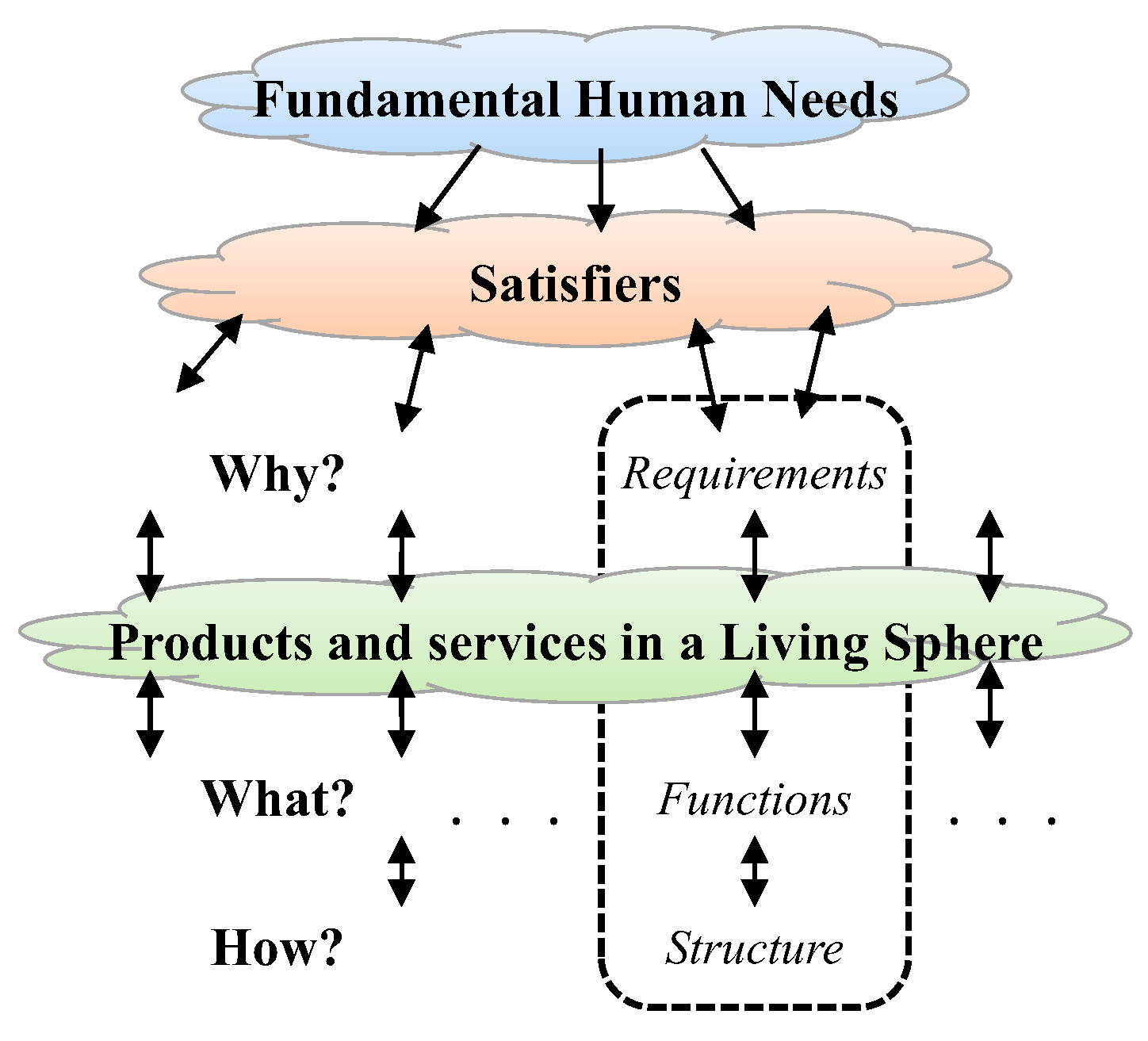
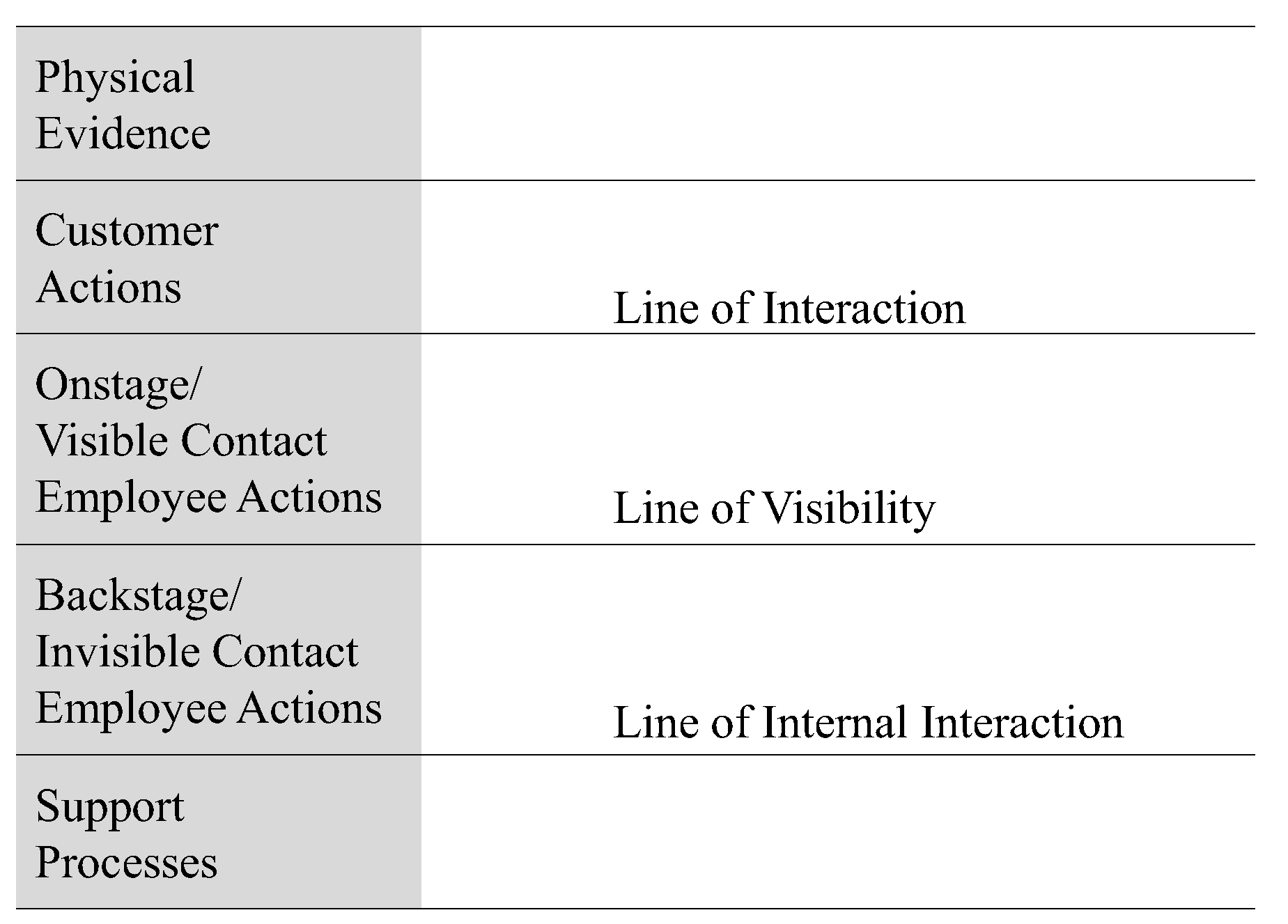
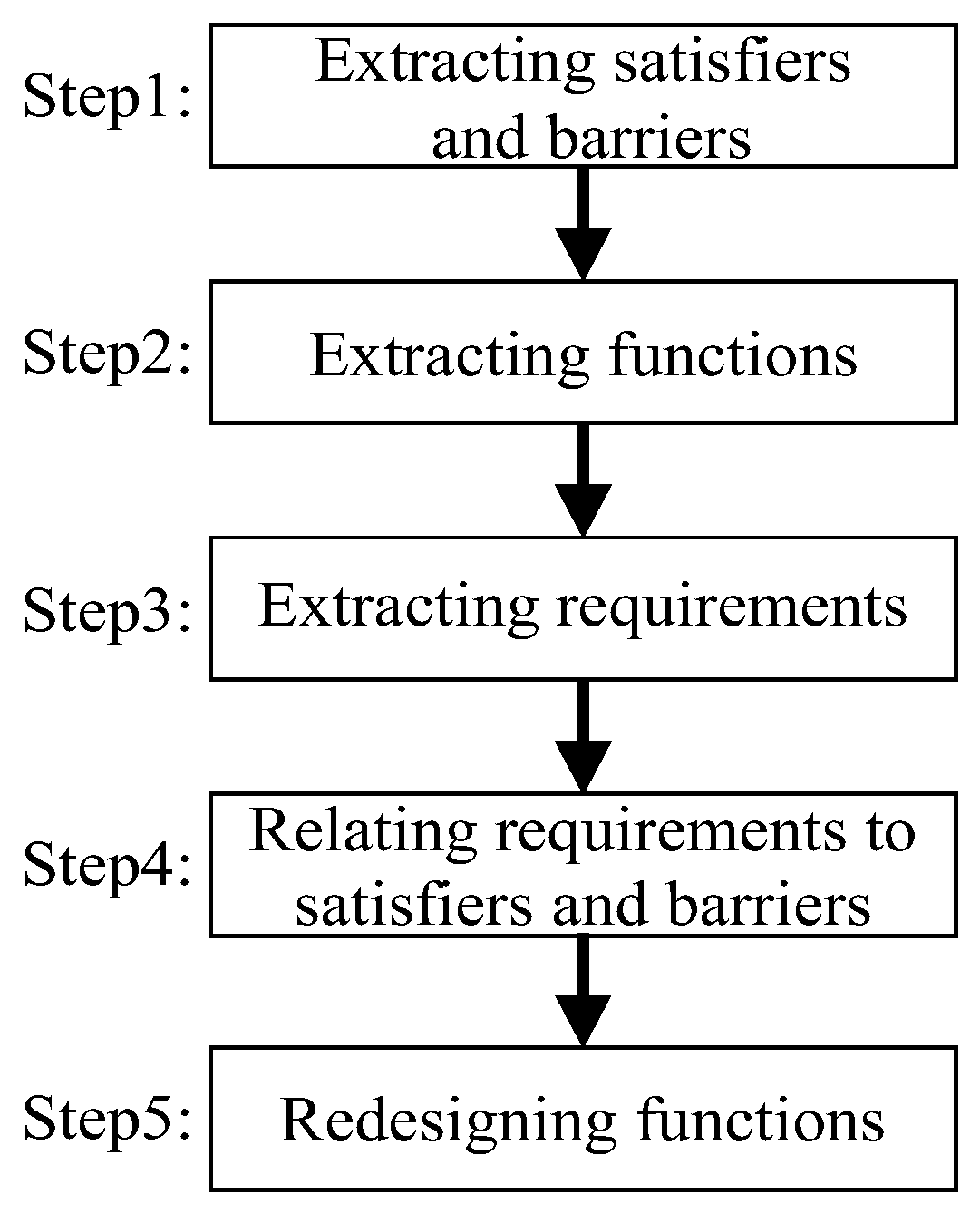
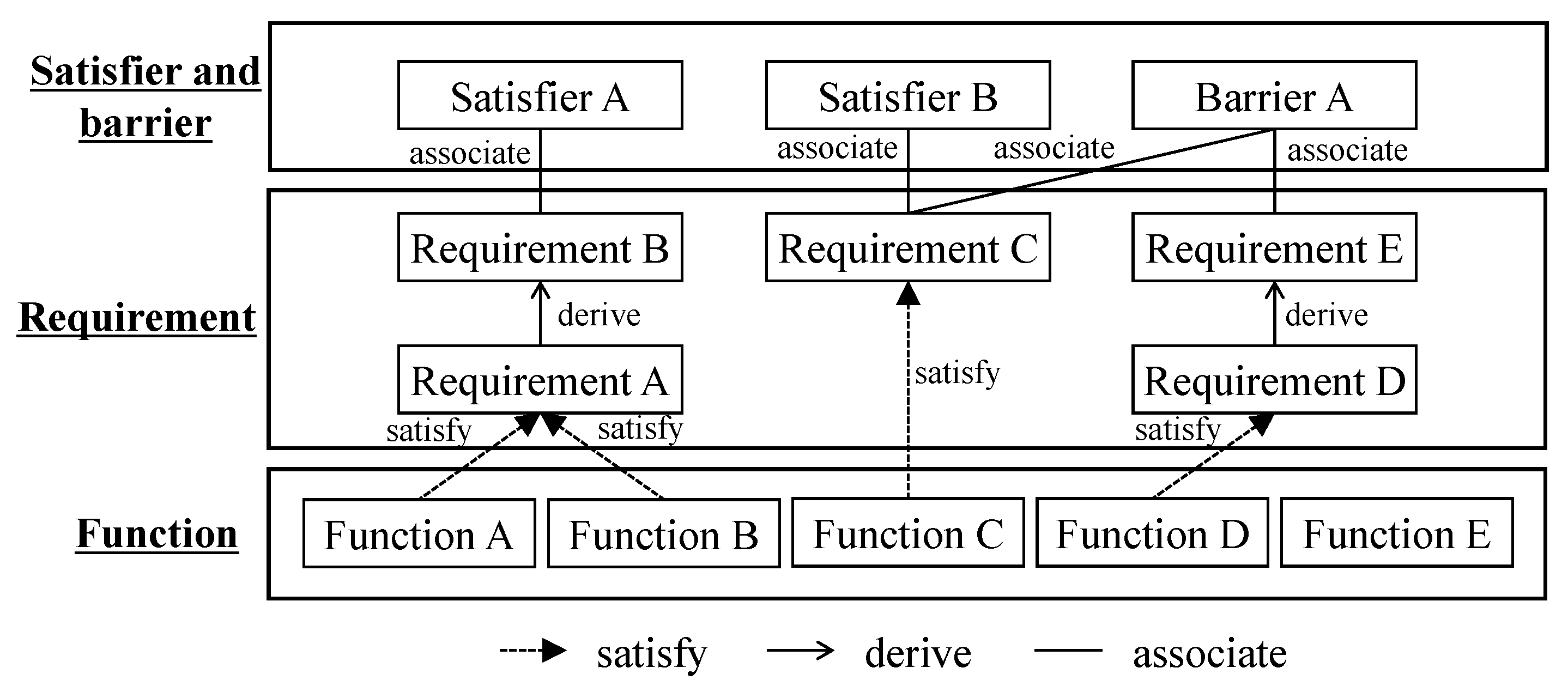

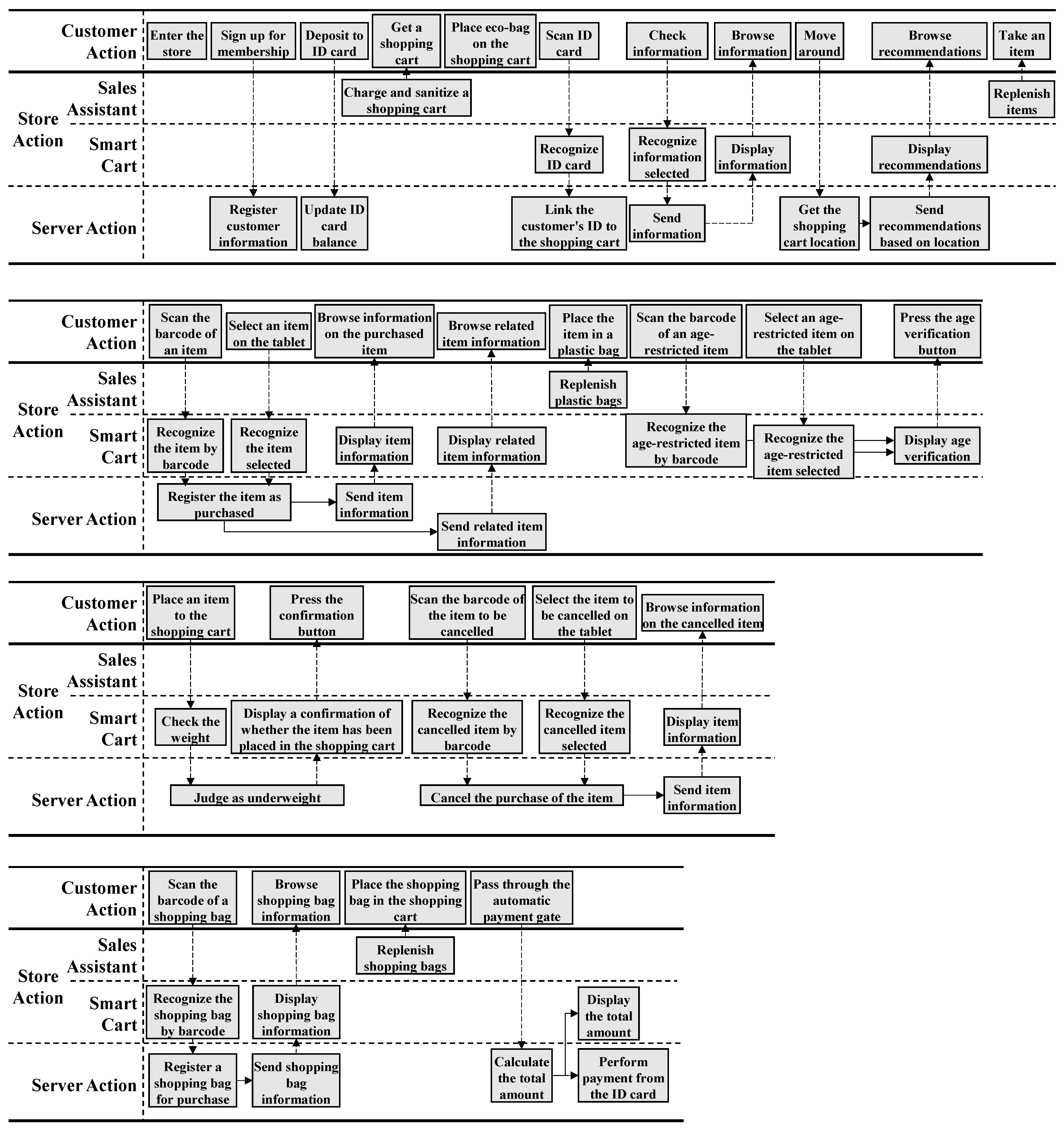
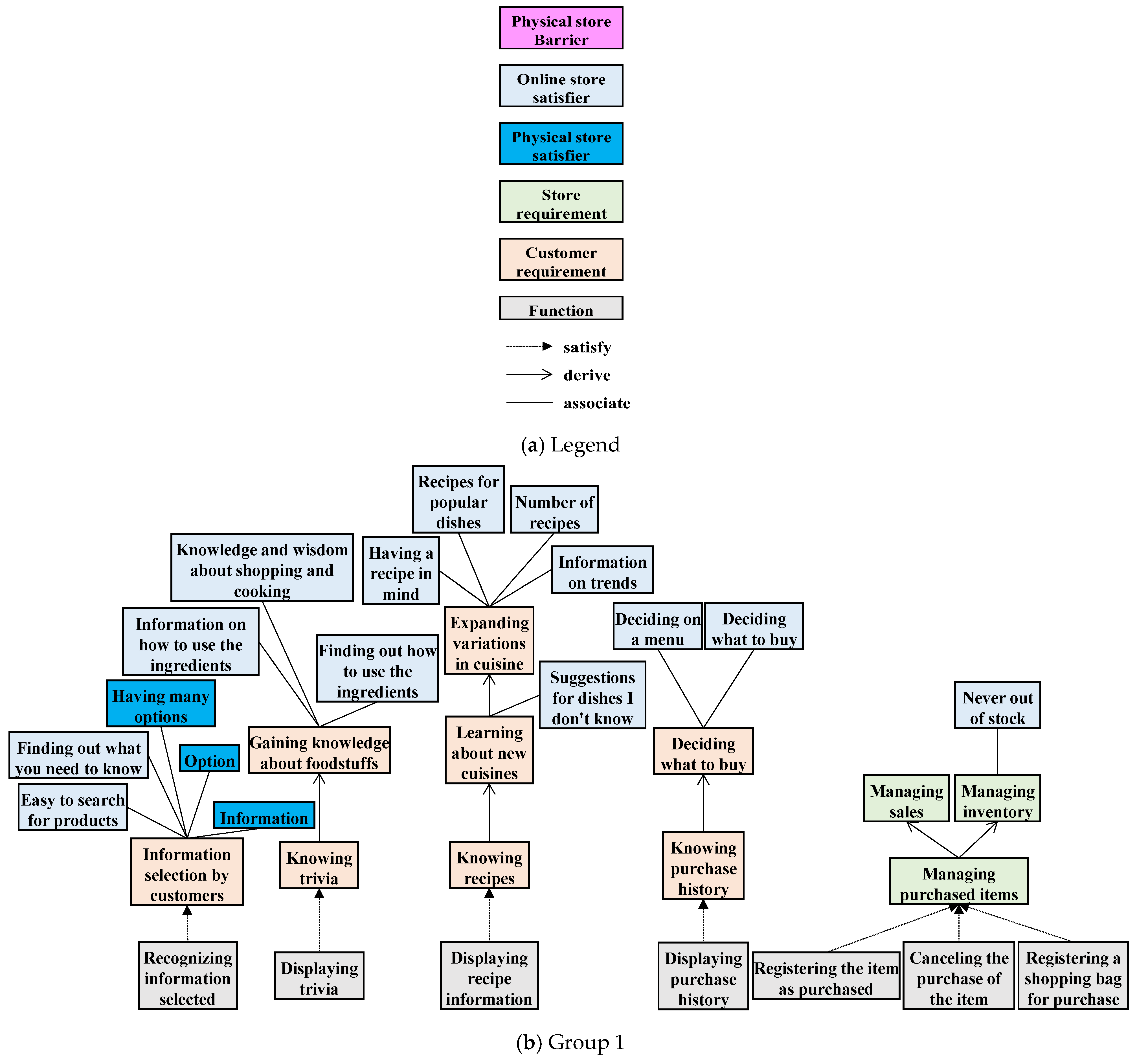


| Being | Having | Doing | Interacting | |
|---|---|---|---|---|
| Subsistence | ||||
| Protection | ||||
| Affection | ||||
| Understanding | ||||
| Participation | ||||
| Idleness | ||||
| Creation | ||||
| Identity | ||||
| Freedom |
| 20s | 30s | 40s | 50s | 60s | |||
|---|---|---|---|---|---|---|---|
| Physical store | Satisfier group | male | 1 | ||||
| female | 1 | 1 | 1 | ||||
| Barrier group 1 | male | 1 | |||||
| female | 1 | 2 | 1 | ||||
| Barrier group 2 | male | 1 | |||||
| female | 3 | ||||||
| Online store | Satisfier group | male | 2 | ||||
| female | 1 | 1 | |||||
| (a) List of Smart-Cart Functions | ||
| Service provider | Action | Function |
| Smart cart | Recognize ID card | Recognizing ID card |
| Recognize information selected | Recognizing information selected | |
| Display information | Displaying special offer | |
| Displaying map information | ||
| Displaying purchase history | ||
| Displaying trivia | ||
| Displaying recipe information | ||
| Display recommendations | Displaying recommendations | |
| Recognize the item by barcode | Recognizing the item by barcode | |
| Recognize the item selected | Recognizing the item selected | |
| Display item information | Displaying item information | |
| Display related item information | Displaying related item information | |
| Recognize the age-restricted item by barcode | Recognizing the age-restricted item by barcode | |
| Recognize the age-restricted item selected | Recognizing the age-restricted item selected | |
| Display age verification | Displaying age verification | |
| Check the weight | Checking the weight | |
| Display a confirmation of whether the item has been placed in the shopping cart | Displaying a confirmation of whether the item has been placed in the shopping cart | |
| Recognize the cancelled item by barcode | Recognizing the cancelled item by barcode | |
| Recognize the cancelled item selected | Recognizing the cancelled item selected | |
| Recognize the shopping bag by barcode | Recognizing the shopping bag by barcode | |
| Display shopping bag information | Displaying shopping bag information | |
| Display the total amount | Displaying the total amount | |
| (b) List of Server Functions | ||
| Service provider | Action | Function |
| Server | Register customer information | Registering customer information |
| Update ID card balance | Updating ID card balance | |
| Link the customer’s ID to the shopping cart | Linking the customer’s ID to the shopping cart | |
| Send information | Sending special offer | |
| Sending map information | ||
| Sending purchase history | ||
| Sending trivia | ||
| Sending recipe information | ||
| Get the shopping cart location | Getting the shopping cart location | |
| Send recommendations based on location | Send recommendations based on location | |
| Register the item as purchased | Registering the item as purchased | |
| Send item information | Sending item information | |
| Send related item information | Sending related item information | |
| Judge as underweight | Judging as underweight | |
| Cancel the purchase of the item | Canceling the purchase of the item | |
| Register a shopping bag for purchase | Registering a shopping bag for purchase | |
| Send shopping bag information | Sending shopping bag information | |
| Calculate the total amount | Calculating the total amount | |
| Perform payment from the ID card | Performing payment from the ID card | |
| Redesign Function | Barrier Removed | Satisfier Enhanced | Need Fulfilled |
|---|---|---|---|
| Adjusting the type and quantity of advertisements to prevent the formation of preconceived notions | advertisements that create preconceived notions, excessive advertising | idleness, understanding | |
| Allowing users to filter or opt out of certain types of information | buying as recommended, excessive information | dissemination of various information, dissemination of adequate information, interest in new things, love of new things | understanding, creation, identity |
| Introducing optional slower checkout lanes with human sales assistants (“chat lanes”) | little communication, fewer employees | time | idelness, affection, freedom |
| Providing producer narratives and detailed product background information | perceiving the producer’s care and dedication, producer information, knowing the story of products | affection | |
| Allowing users to register allergy information and dietary preferences | knowing food preferences in the family, ingredient allergies | affection, understanding |
Disclaimer/Publisher’s Note: The statements, opinions and data contained in all publications are solely those of the individual author(s) and contributor(s) and not of MDPI and/or the editor(s). MDPI and/or the editor(s) disclaim responsibility for any injury to people or property resulting from any ideas, methods, instructions or products referred to in the content. |
© 2025 by the authors. Licensee MDPI, Basel, Switzerland. This article is an open access article distributed under the terms and conditions of the Creative Commons Attribution (CC BY) license (https://creativecommons.org/licenses/by/4.0/).
Share and Cite
Murata, H.; Kobayashi, H. A Needs-Based Design Method for Product–Service Systems to Enhance Social Sustainability. Sustainability 2025, 17, 3619. https://doi.org/10.3390/su17083619
Murata H, Kobayashi H. A Needs-Based Design Method for Product–Service Systems to Enhance Social Sustainability. Sustainability. 2025; 17(8):3619. https://doi.org/10.3390/su17083619
Chicago/Turabian StyleMurata, Hidenori, and Hideki Kobayashi. 2025. "A Needs-Based Design Method for Product–Service Systems to Enhance Social Sustainability" Sustainability 17, no. 8: 3619. https://doi.org/10.3390/su17083619
APA StyleMurata, H., & Kobayashi, H. (2025). A Needs-Based Design Method for Product–Service Systems to Enhance Social Sustainability. Sustainability, 17(8), 3619. https://doi.org/10.3390/su17083619







